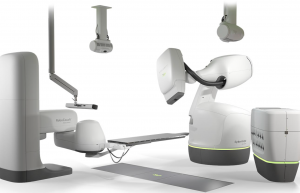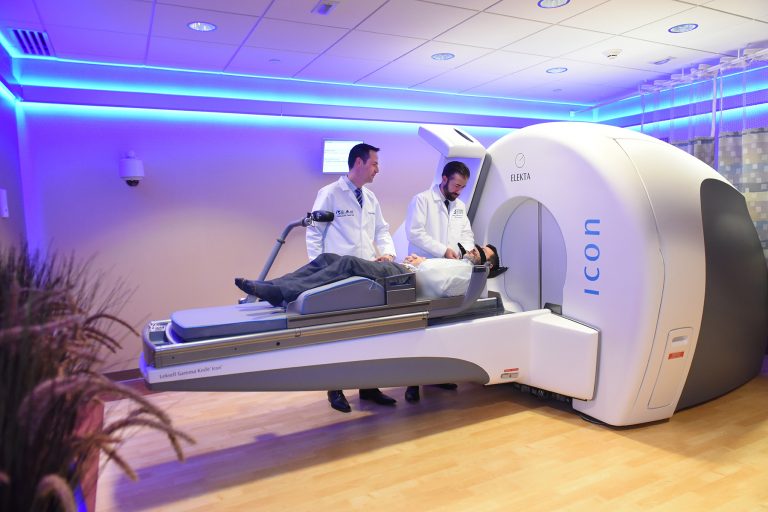Cyberknife Radiation
Anthony D’Ambrosio, M.D., M.B.A., F.A.A.N.S
Table of Contents
Cyberknife Radiation - What is it?
CyberKnife radiation is an image-guided stereotactic system designed to deliver radiation as both focal irradiation and radiation therapy (SRT). Focal irradiation refers the use of many small radiation beams designed to deliver a highly focused dose to a small target region in a few fractions.
The system consists of a 6-MV linear accelerator (linac) mounted to a robotic arm, coupled with a digital x-ray imaging system. The radiation treatment is delivered using many X-ray beams or photons oriented at a number of defined or nodal positions around the patient. The CyberKnife can be used for both intracranial (brain) and extracranial (body) treatments (1).
When was Cyberknife first introduced?
The Cyberknife was first introduced in 1994 by Dr. J.R. Adler et al. As Dr. Adler puts it, “the Cyberknife is a unique instrument for performing frameless stereotactic radiosurgery.
Rather than using rigid immobilization, Cyberknife systems rely on an image-to-image correlation algorithm for target localization. Furthermore, the system utilizes a novel, light-weight, high-energy radiation source.”(2) The real time imaging capabilities of the Cyberknife radiation platform allows the system to increase accuracy while radiation is being given to the patient.
What can Cyberknife treat and how does it work?
The Cyberknife is used for treating cancerous tumors throughout the body, including the prostate (prostate cancer), lung, brain, spine, head and neck, liver, pancreas and kidney, and can be an alternative treatment option to surgery or for patients who have inoperable or surgically complex tumors.
CyberKnife treatments are typically performed in 1 to 5 sessions (aka, trips to the treatment center), especially in the setting of cancer treatments.(3) In the case of stereotactic body radiation therapy, treatment plans can include more than 5 sessions. When Cyberknife radiation is used for brain tumors, patients are fitted for a customized mask to “immobilize” their head for accuracy during treatment to minimize patient movement.
Gamma Knife - How is it different from Cyberknife?
Gamma Knife is a different platform from Cyberknife.
The Gamma Knife is fully dedicated to the brain only. The Cyberknife can treat a variety of different parts of the body. The Gamma Knife uses gamma rays that come from small radioactive cobalt sources in the head of the machine. Gamma Knife doesn’t use photons generated by a linear accelerator and has fewer moving parts than the Cyberknife.
The Gamma Knife was introduced in 1968 which means that over 50 years of data stands behind the Gamma Knife platform. Cyberknife was introduced in 1994, so a large body of data also exists for the Cyberknife platform. Both platforms have a great track record for treating tumors effectively, with high dose radiation while protecting surrounding healthy tissue.
For cancerous brain tumors, the same dose of radiation can be given by both the Gamma Knife and the Cyberknife safely and effectively. For some brain surgeons, benign brain tumors like acoustic neuromas have a longer safety record on the brain-only platform, the Gamma Knife. For more information on Cyberknife vs Gamma Knife, click here.
Brain surgery alternatives - Know your options
Stereotactic Radiosurgery (aka SRS) can be a great non-surgical treatment option for many patients. SRS is very different from traditional radiation therapy and traditional surgery (with a knife). Cyberknife and Gamma Knife are safe and effective platforms with extensive data supporting their safety and quality when it comes to brain surgery alternatives and radiosurgery. To learn more, make sure you speak to a doctor who has experience with radiosurgery and traditional brain surgery.
If you are trying to figure out the best treatment option for you, make sure you are talking to the right team. You must consider the safety, efficacy, and side effects of any treatment you are considering. Depending on your specific problem, Cyberknife radiation or Gamma Knife Radiosurgery might be the best option for you.
References
- Ding C, Saw CB, Timmerman RD. Cyberknife stereotactic radiosurgery and radiation therapy treatment planning system. Med Dosim. 2018 Summer;43(2):129-140. doi: 10.1016/j.meddos.2018.02.006. Epub 2018 Mar 28. PMID: 29605528.
- Adler Jr. J, R, Chang S, D, Murphy M, J, Doty J, Geis P, Hancock S, L: The Cyberknife: A Frameless Robotic System for Radiosurgery. Stereotact Funct Neurosurg 1997;69:124-128.
- Cyberknife.com
- Martin A, Gaya A. Stereotactic body radiotherapy: a review. Clin Oncol (R Coll Radiol). 2010 Apr;22(3):157-72. doi: 10.1016/j.clon.2009.12.003. Epub 2010 Jan 25. PMID: 20092981.
Get Your Questions Answered, By a Real Person.
Our Patient Liaisons are here to help you understand your next step. After discussing your specific case, they can help you navigate your medical records, answer insurance questions, and connect you with one of our nurses, at no charge to you.
For your convenience and safety, we offer both virtual and in-person consultations. Reach out today by calling: 201-634-5610.



